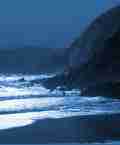

Cahir Castle,
County Tipperary
Superbly set on a rocky island in the River Suir, this impressive 15th-century castle - the largest of its period in Ireland - was considered impregnable until the advent of heavy cannon. Described by one Elizabethan commentator as "the bulwark for Munster and a safe retreat for all the agents of Spain and Rome", it fell to Devereux, Earl of Essex, in 1599 after it had been battered for two days with artillery. It surrendered without a fight to Inchiquin in 1647 and again to Cromwell in 1650, but otherwise had a notably undistinguished history, which possibly helps to explain why it survives in such remarkably good condition today. Making excellent use of the rocky terrain, its layout comprised a series of courts which cleverly served as successive lines of defence, so that each ward or court dominated the one outside. The core of the castle is surrounded by very thick curtain walls, the lowest parts of which belong to the original fortress on the site built by Philip of Worcester in the 13th century. The massive wall-footing across the middle ward marks the south perimeter of this early castle, while the large adjacent building, known as the keep, originally served as the gatehouse, with a passage through the centre flanked by guard chambers. After this was converted into the main residential block of the castle in the 15th century, the gate was moved alongside, possibly with its original arch. The double machicolation over this entrance is largely an 1840s reconstruction, but the adjacent round tower, which served as a prison, may also have 13th-century foundations.
The present castle appears to be largely the work of Seamus Gallda (James the Foreigner), ancestor of the Butlers, Barons of Cahir. After the death of his father, the third Earl of Ormonde, in 1405, James Butler made Cahir his principal seat and embarked on a building programme. By 1599 the castle had reached its present appearance as illustrated in Pacata Hibernia. The only subsequent alterations took place in the 1840s when Richard Butler restored the castle and replaced the picturesque Irish battlements with more solid English ones. The great hall on the east side of the inner ward was also rebuilt at this time though its original form extended much further south; indeed, the main fireplace now lies outside in the open. The Butlers ceased to occupy the castle in the 18th century and built a house in the town, now the Cahir House Hotel. In the 1860s they erected a mansion, Cahir Park, in the magnificent parkland which adjoins the old castle.Cahir town. NGR: S 048248.
Click here Irish Castles to buy the newly reformatted book from Amazon.co.uk. The previous edition of Irish Castles is also still available from Amazon.co.uk.
